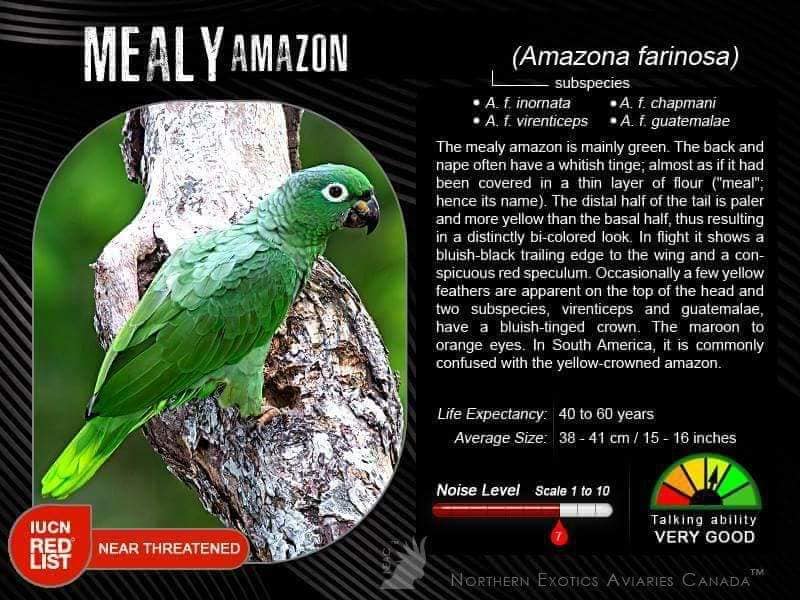Southern Mealy Amazon - Amazona Farinosa - Near Threatened
The Southern Mealy Amazon or southern mealy parrot (Amazona Farinosa) is among the largest parrot in the genus Amazona, the amazon parrots. It is a mainly green parrot with a total length of 38–41 cm (15–16 in). It is endemic to tropical Central and South America. This species and the northern mealy amazon were previously considered conspecific. Some taxonomic authorities (including the American Ornithological Society, continue to lump them together.
Range, Common Names and Races - The southern mealy amazon occurs in tropical Central America and South America. It frequents humid to semi-humid forest (only rarely in deciduous forest) and plantations. In regions dominated by open/dry habitats it is restricted to gallery forest or completely absent.
Three subspecies have been described and these have alternative common names that are used frequently in aviculture:
Amazona Farinosa Farinosa - Nominate Species - Found in southeastern Colombia, southern Venezuela, the Guianas, Brazil and northern Bolivia.
Amazona Farinosa Inornata - Found in eastern Panama, western and northern Colombia, northwestern Venezuela and western Ecuador. Also known as the plain-colored mealy amazon.
Amazona Farinosa Chapmani - Found in southeast Colombia, eastern Ecuador, eastern Peru and northeastern Bolivia. Also known as the Chapman's mealy amazon.
NOTE: Exact distribution limits between nominate, inornata and chapmani are unclear.
Description - The southern mealy amazon has a total length of about 38–41 cm (15–16 in)[2][3] and weighs 540–700 g (19–25 oz). Captives commonly are heavier. It is among the largest parrots in the Americas, mainly being surpassed by the large macaws. It has a relatively short and square shaped tail, as do the other members of the Amazona genus. The southern mealy amazon is mainly green. The back and nape often have a whitish tinge; almost as if it had been covered in a thin layer of flour ("meal"; hence its name). The distal half of the tail is paler and more yellow than the basal half, thus resulting in a distinctly bi-colored look. In flight it shows a bluish-black trailing edge to the wing and a conspicuous red speculum. Occasionally a few yellow feathers are apparent on the top of the head.
In South America, it is commonly confused with the yellow-crowned amazon, but can be recognized by its larger size, less yellow to the crown (not entirely reliable, as some yellow-crowned may show almost none), the whitish tinge to its plumage, broader white eye-ring, and red of the leading edge of the wing placed near the phalanx (not near the radiale), but this is often difficult to see (especially on perched birds). Their voices are also strikingly different.
Behavior - The southern mealy amazon is social and can be found in pairs or in large flocks. They are even known to interact with other parrots, such as macaws. They are usually quiet but can be loud at dusk and dawn. In captivity, they are known as one of the gentlest and calmest of all amazons. The mealy amazon is bred in captivity with some regularity.
Diet - The diet of the mealy amazon consists mostly of fruits, seeds, berries, nuts, blossoms, and leaf buds.
Breeding - After southern mealy amazons reach sexual maturity they usually form monogamous relationships with a single partner. Each year courtship usually begins in early spring, and the female will usually lay three or four white eggs in a tree-cavity nest. The female incubates the eggs for about 26 days. The male regurgitates food for the female during the incubation period, and later for the chicks in the nest as well. The chicks leave the nest about 60 days after hatching.[4]
Status and Conservation - It is fairly common in most of its range, but has declined locally due to habitat loss and trapping for the wild parrot trade. Trafficking of the birds (as for exotic pets) is illegal in many nations, but the species are still smuggled into the United States from Mexico. In some areas southern mealy amazons are hunted as food. The southern mealy amazon sometimes feeds on human crops (especially corn) and may be considered a crop pest.

Psittaciformes, The Parrot Index, a part of Phoenix Feathers © 2016 - 2023
Page last updated: 12/24/23
Phoenix Feathers

